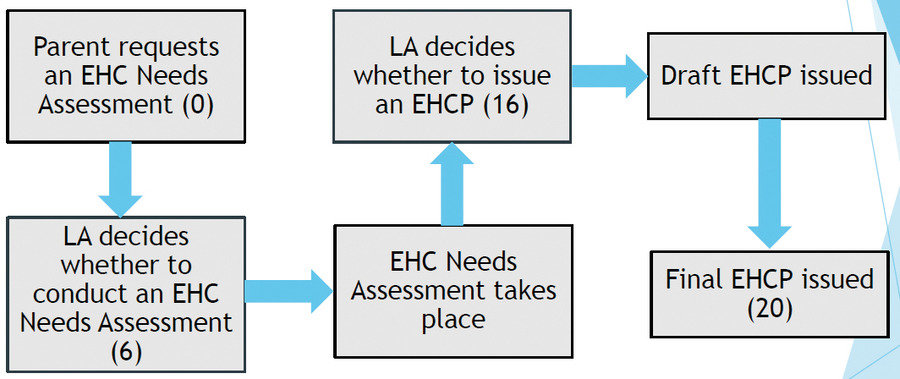Let’s Get It Clear: Education Health and Care Plans – The essentials for success

At the July joint sections meeting of the BHTA, Guv Kaur, a Public Law Specialist Lawyer from Taylor Price Solicitors, shared her knowledge and experience as to what needed to be included, and what should be avoided, in a successfully executed Education Health and Care Plan (EHCP). This article summarises the key points made to optimise the funding provision. This will be of value to BHTA members supplying equipment to support an EHCP in England, and the help and advice that they can give their customers with youngsters who are eligible for an EHCP.
An Education, Health and Care Plan (EHCP) is a legal personalised document. It sets out the education, health, and social care needs of a child or young person (aged 0 to 25 years old) (CYP) with special educational needs or disabilities, and who needs more support in their educational setting beyond the usual resources provided.
An EHCP should not be confused with an Individualised Education Plan (IEP), which is completely determined by the young person’s school, whereas the law determines an EHCP, and so the family’s Local Authority (LA) is under a legal duty to put it in place.
It is important to note that there is no lower nor upper limit on the amount of funding to be provided by the LA. Further, a LA cannot legitimately refuse to provide the prescribed specialist equipment in the EHCP on the basis that “it doesn’t stock that particular type of equipment”, or “that an alternative is available in the school”, etc.
The process
You can ask your LA to carry out an EHC Needs Assessment if you think your child needs an EHC plan. A young person can request an assessment themselves if they’re aged 16 to 25. A request can also be made by anyone else who thinks an assessment may be necessary, including doctors, health visitors, teachers, and family friends.
The LA has six weeks to decide whether they accept that criteria have been met, and will carry out an EHC Needs Assessment. As part of the assessment the LA may ask for:
• any reports from the child’s school, nursery, or childminder
• doctors’ assessments of the child
• a letter from the applicant about the child’s needs
The local authority is required to tell you within 16 weeks of your application whether an EHC plan is going to be made for your child, and then they have a further four weeks in which to draft and finalise the EHCP.
In that four-week period you have at least 15 days to comment, including if you want to ask that your child goes to a specialist needs school or specialist college.
The EHCP
The Children and Families Act 20141 (section 37) describes what an EHC plan is and what it must include. There are some useful ‘dos’ and ‘don’ts’ to be aware of when completing the EHCP. The EHCP is made up of 11 sections (Table 1).
Anything that is written up outside those 11 sections carries no weight. The most important ‘do’ is to make sure that anything that needs to be funded is included in Sections B, F, and I, the sections which cover Special Educational Needs, including any items that also come up in sections C and G (the Health Needs).
Description of Needs (section B) informs the content of Special Educational Provision (section F) which informs the Placement (section I). Any support specified in Section F cannot be withdrawn by the LA without following a formal review/amendment of EHCP process.
Section B: Describing special educational needs
‘Special Educational Needs’ is a learning difficulty or disability which requires special educational provision. A child or young person has a learning difficulty or disability if they have significantly greater difficulty in learning than the majority of others of the same age, or they have a disability which makes it difficult for them to use the facilities normally provided for others of the same age in mainstream schools or post-16 institutions.
Someone has a disability if they have a physical or mental impairment which has a substantial and long-term adverse effect on their ability to carry out day-to-day activities.
Section F: What constitutes provision in an EHCP?
Special educational provision is any educational or training provision that is additional to, or different from, that made generally for other children or young people of the same age.
The provision, whether equipment or support, is specific to the child. Special educational provision is anything that ‘educates or trains’ a child or young person. This can include therapies provided by the health authorities or social care.1
There is no legal prescribed list of specific items of provision to be included in an EHCP. For examples, see Table 2.
Individual LAs will often have types of provision it routinely considers to be provision and includes in EHCPs. While this can be a useful guide, it should not be considered a full reflection of what can be secured in an EHCP. The more unusual the provision, the more likely you are to face LA resistance to inclusion.
Section F has the ‘strongest’ enforceability, but for provision to be deemed educational and included in section F, it needs to link to meet an educational need in section B. (The same applies to sections C and G.) Note that, legally, a child or young person is entitled only to that which is suitable to their age, aptitude, ability, and SEND, and not ‘best provision’.
Getting the specification right
All of the needs specified in section B should be provided for. Provision must be detailed, specific, and quantified. It should be clear as to “who, what, when, and how long” in relation to each element of the provision. Referring to a funding ‘band’, without further detail, is not specific enough – detail the provision (not the cost).
If the words used in the plan are unclear or ‘woolly’, it is possible the special educational provision will not be delivered in the right quantity, or by the right person (it is even possible it will not be provided at all!).
Make it clear exactly what support the child or young person needs. It is not sufficient for the LA to leave it up to the school. It is also not lawful for the LA to leave the provision open to variation, for example by including words such as “the level of provision is to be reviewed after one term”. If the LA wants to change the level of provision, it can only do so by amending the EHCP.
Pointers on report writing
• Read through the Department of Education’s SEND Code of Practice2 (292 page) document, especially pages 164-169 which provide more detailed information around the 11 sections of an ECHP.
• Specify all of the CYP’s Special Educational Needs in section B that relate to the provision being recommended in section F, and vice versa.
• Explain in full why the provision being recommended is necessary to meet those needs.
• If the same broad area of needs requires more than one type of provision, split this into a list of the CYP’s Special Educational Needs and then describe the required special educational provision for each.
• Apply this to sections C and G, only if you can’t make the provision fall within section F.
• Avoid talking about recommend provision as ‘best’, ‘top of the range’, or the latest technological development.
• If appropriate, give examples of successful use of the recommended provision.
• Don’t forget that the young person may need the same item at home as at school for homework and similar related educational purposes, and so both need to be provided for in the EHCP.
Further reading
- www.legislation.gov.uk/ukpga/2014/6/part/3/enacted
- HM Department of Education SEND Code of Practice (2015) Special educational needs and disability code of practice: 0 to 25 years. Statutory guidance for organisations which work with and support children and young people who have special educational needs or disabilities.
Table 1: The sections of an ECHP
• Section A: The views, interests, and aspirations of the child or young person (CYP)
• Section B: The CYP’s Description of Special Educational Needs (SEND)
• Section C: Any health needs relating to their SEND
• Section D: Any social care needs relating to their SEND
• Section E: The intended outcomes for the CYP, which should be joined across education, health, and social care, where appropriate
• Section F: What special educational provision is needed for the CYP’s SEND
• Section G, H1, H2: What provision is needed from health or social care services
• Section I: Name and type of education placement
• Section J: Details of any agreed personal budgets
• Section K: Advice and information gathered through the EHC Needs Assessment
Note: The SEND Code of Practice2 describes (pp 164-9) in detail what is included in each section of the EHC Plan.
Table 2: Examples of SEN provision
• Therapy equipment
• Therapies
• Adapted learning materials
• Hardware – e.g. laptops, magnifiers
• Software
• Assistive Technology for communication
• Assistive Technology for curriculum differentiation
• Specialist seating
• Whole School training
• Learning material differentiation specification
Further items can be found at www.beshealthcare.net. If you are interested in receiving further information on the topic, please contact 
Dr Barend ter Haar has been involved in seating and mobility for over 30 years, including lecturing internationally and developing international seating standards.



